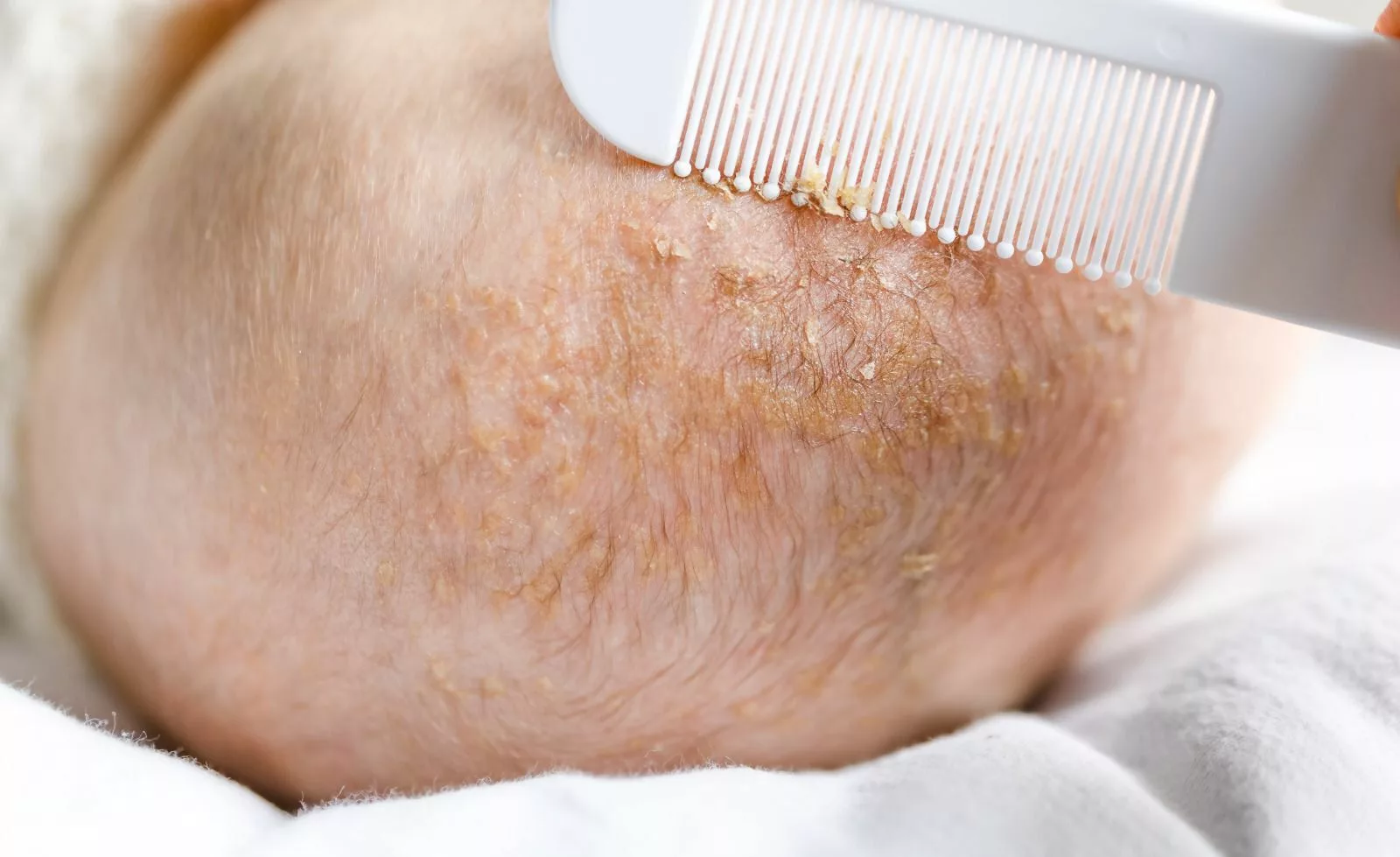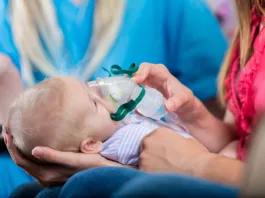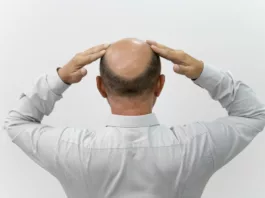Cradle cap, also known as infantile seborrheic dermatitis, is a chronic, common skin condition in newborn babies characterized by greasy, yellow patches on the scalp. Around 70% of babies between 1 to 3 months old get this condition.1Hassan, S., Szeto, M. D., Sivesind, T. E., Memon, R., Muneem, A., Victoire, A., Magin, P. J., van Driel, M. L., Nashawaty, M., & Dellavalle, R. P. (2022). From the Cochrane Library: Interventions for infantile seborrheic dermatitis (including cradle cap). Journal of the American Academy of Dermatology, 86(2), e87–e88. https://doi.org/10.1016/j.jaad.2021.09.031 It usually goes away on its own within a few months to a year. The term cradle cap comes from its common appearance on the scalp, where a baby might wear a cap. While you may look at it as concerning, the cradle cap is harmless and generally treated with conservative methods.
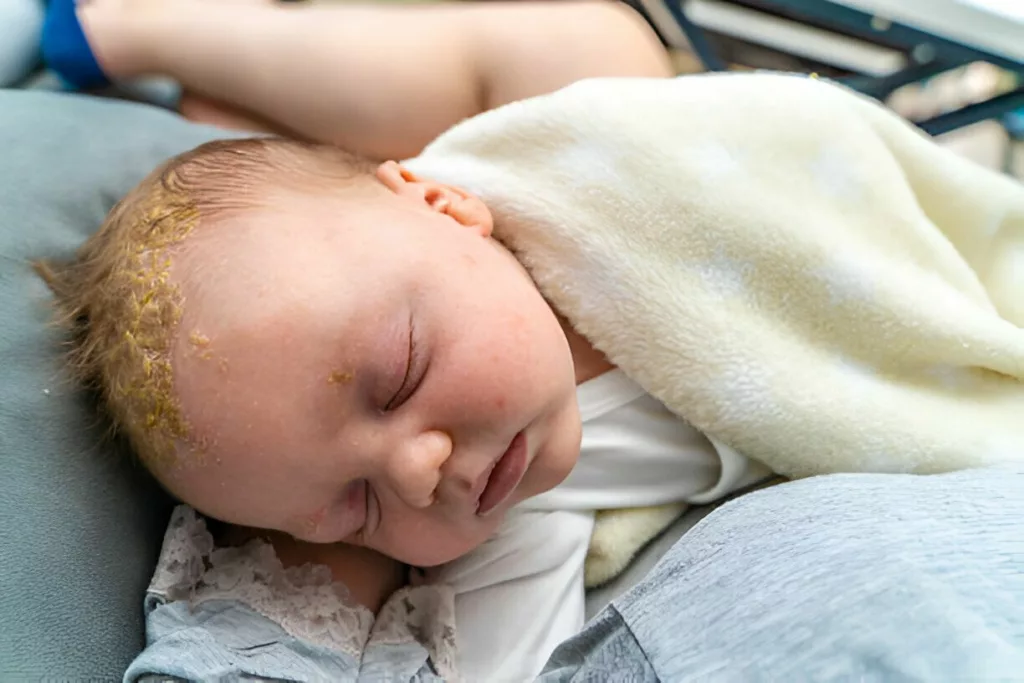
What is a Cradle Cap?
Cradle cap is a common skin condition in infants, typically appearing within the first few months of life, often starting around the third week. It is a mild form of seborrheic dermatitis characterized by non-inflammatory, scaly patches that usually occur in areas with sebaceous (oil-producing) glands. While it most frequently affects the scalp, it can also appear on the face, eyebrows, eyelids, external ears, or even in skin folds. The condition causes erythematous (red), yellowish, or greasy scales. It is generally not painful or itchy and resolves on its own over time in most cases.
What causes a Cradle Cap?
The exact cause of the condition is unknown. However, several factors contribute to its development. Circulating hormones from the mother, either before birth or during breastfeeding, may cause overactivity of the sebaceous glands. Hormonal changes can also trigger these oil-producing glands to become more active. Excess oil from these glands causes dead skin cells to stick to the skin instead of shedding off, resulting in a scaly appearance.
Another factor is the involvement of a yeast called Malassezia, particularly species like M. globosa and M. restricta. This yeast thrives in the warm, oily environment of the baby’s scalp, breaking down sebum and producing byproducts that may irritate the skin and contribute to flaking. While Malassezia is not the sole cause, its presence and activity are closely associated with the condition. Environmental factors, such as warmth and moisture, can further promote the growth of this yeast, exacerbating symptoms.2Naldi, L., & Diphoorn, J. (2015). Seborrhoeic dermatitis of the scalp. BMJ clinical evidence, 2015, 1713
Symptoms of the Cradle Cap
This condition does not affect your baby’s health; it does not cause pain or feeding problems, and your baby may not even notice it. However, you might observe dandruff-like scaly skin on your baby’s scalp. When you touch it, you may feel a greasy and waxy texture. These yellow patches may appear as fish scales and look crusted with flakes. If your baby has a light skin tone, the patches may be surrounded by a red or pink rash.
Cradle cap primarily affects the scalp but may extend to the eye and forehead area, external ear area, diaper zone, umbilical area, and the neck or arm area. These areas other than the scalp appear more erythematous than scaly.3Nobles T, Harberger S, Krishnamurthy K. Cradle Cap. [Updated 2023 Aug 7]. In: StatPearls [Internet]. Treasure Island (FL): StatPearls Publishing; 2024 Jan-. Available from: https://www.ncbi.nlm.nih.gov/books/NBK531463/
Diagnosis of the Cradle Cap
A doctor can diagnose a cradle cap through a visual examination of the affected area. The presence of yellow, greasy, scaly patches on the baby’s scalp is typically sufficient for diagnosis. No special laboratory tests are usually required, as the condition is easily recognizable based on its distinctive appearance and location.4InformedHealth.org [Internet]. Cologne, Germany: Institute for Quality and Efficiency in Health Care (IQWiG); 2006-. Seborrheic dermatitis: Learn More – Seborrheic dermatitis in babies (cradle cap) [Updated 2024 Feb 1]. Available from: https://www.ncbi.nlm.nih.gov/books/NBK559360/
Cradle cap is also distinguished from other conditions, such as atopic dermatitis or fungal infections, by its characteristic lack of redness, irritation, or significant itchiness in most cases. This differentiation helps ensure an accurate diagnosis and provides reassurance to parents, as cradle cap is generally harmless and self-limiting.
Risk factors for the Cradle Cap
The specific risk factors for cradle cap are not fully known. However, the condition primarily affects newborns and infants, particularly within the first few months of life. It is more common during this period due to the natural activity of the sebaceous glands, which diminishes as the baby grows older.
Treatment for Cradle Cap
Cradle cap is generally treatable at home once diagnosed by a healthcare professional. The condition is usually mild and resolves with consistent care.5Sheffield, R. C., Crawford, P., Wright, S. T., & King, V. J. (2007). Clinical inquiries. What’s the best treatment for a cradle cap? The Journal of family practice, 56(3), 232–233 Here are the most common treatment strategies:
-
Washing:
Keeping the scalp clean is key in managing the cradle cap. Washing the baby’s scalp regularly can help remove excess oil and flakes. Most doctors recommend using an unscented baby shampoo daily. Gently rub the shampoo onto the affected areas, being careful not to irritate the skin. If standard baby shampoo does not resolve the symptoms, a pediatrician may recommend a medicated shampoo containing ingredients like selenium sulfide or ketoconazole to address potential fungal involvement.
-
Brushing:
After washing, use a soft-bristled brush or a fine-toothed comb to gently lift and remove the flakes. This helps to prevent build-up and encourages normal skin shedding. Be sure to handle the scalp with care to avoid causing discomfort or irritation.
-
Soften the Skin:
Applying petroleum jelly, baby oil, mineral oil, or emollients to the affected area can soften the scales and improve skin condition. These oils help to break down the scales, making them easier to remove with gentle brushing. For best results, massage the oil into the scalp and leave it on for several hours or overnight before washing the scalp. This can also help prevent dryness and further scaling.
-
Using Anti-fungal Cream:
If the cradle cap is suspected to be caused by a fungal infection, which is common due to the presence of Malassezia yeast, antifungal creams may be recommended. These creams help manage yeast growth and prevent further scaling. Your doctor might prescribe topical antifungal treatments, such as ketoconazole or clotrimazole. It’s important to follow the doctor’s instructions and avoid using over-the-counter creams, especially those containing steroids unless specifically advised by a healthcare provider.6Schwartz, R. A., Janusz, C. A., & Janniger, C. K. (2006). Seborrheic dermatitis: an overview. American family physician, 74(1), 125–130
-
Avoid Scratching:
Although it can be tempting to scratch the scales, doing so can lead to further irritation and potential infection. Scratching may damage the skin, increasing the risk of complications, such as bacterial infections. Be sure to keep the baby’s nails trimmed and discourage scratching, even if the scalp feels itchy.
-
Medical Follow-up:
In some cases, cradle cap may persist or worsen despite home care. If this happens, a pediatrician might investigate other possible underlying conditions, such as seborrheic dermatitis or an allergic reaction. In rare cases, cradle cap may require a more intensive treatment regimen, including prescription-strength topical treatments.
How long does the cradle cap persist?
The cradle cap usually goes away on its own in six to twelve months. Home treatments can help speed up the recovery. If home remedies aren’t working and the condition doesn’t improve, visit your baby’s doctor. The doctor will examine the baby’s scalp and affected areas to check for any other skin conditions that may require treatment.
Prevention for the Cradle Cap
Washing your baby’s hair and scalp frequently will help avoid the cradle cap. Use fragrance-free and mild shampoo for the wash unless your doctor recommends any other medicated product.
When to see a doctor?
If your baby’s condition is not improving and you notice these symptoms. Consider visiting a doctor;
- The scalp or affected area is hot to touch
- You notice an oozing of fluid or blood from the affected area
- Redness over the area
- You suspect bad odor from your baby’s scalp or affected area
Cradle cap vs. Eczema
Eczema, also known as atopic dermatitis, is a chronic skin condition characterized by dry, red, inflamed patches that may appear bumpy, rough, and swollen. These patches can be itchy and may also develop yellowish crusting. The exact cause of eczema is unclear, but it is thought to involve a combination of genetic and environmental factors that impair the skin’s barrier function, making it more susceptible to irritation. Common triggers for eczema flare-ups include irritants such as extreme weather, fragrances, food allergens, and stress. Unlike cradle cap, which mainly affects the scalp of infants, eczema can occur anywhere on the body and may appear at any age, often in areas like the face, elbows, and knees.7(Strathie Page, S., Weston, S., & Loh, R. (2016). *Atopic dermatitis in children*. Australian Family Physician, 45(5), 293–296)
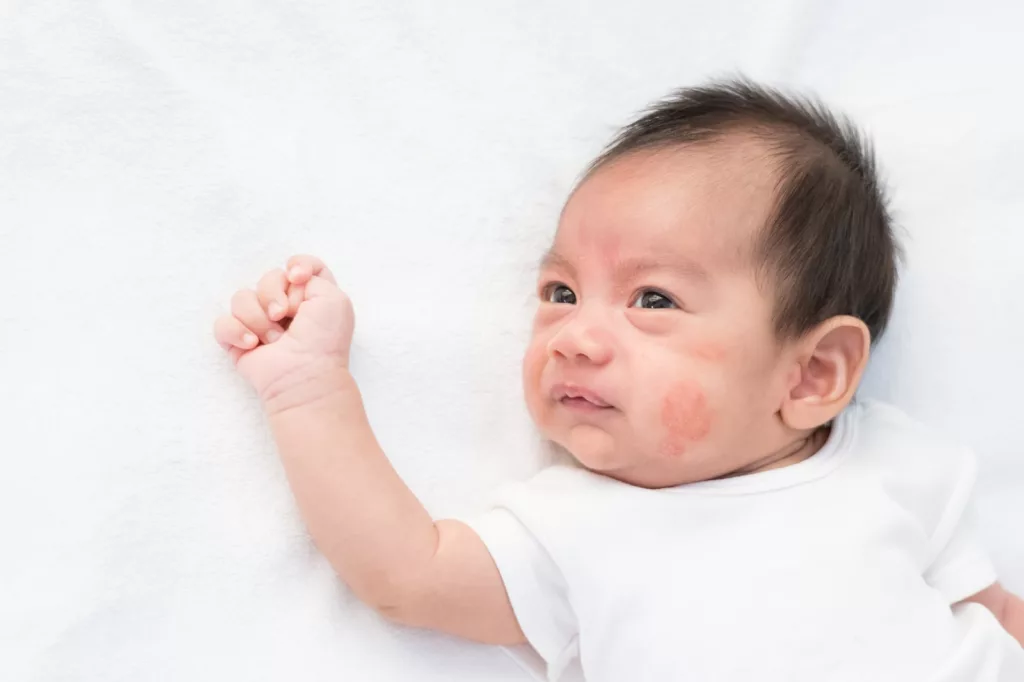
Both conditions appear similar and it is difficult to separate both. However, there are some factors that can make it easy to differentiate between both conditions. The very first sign that separates both is itch. Cradle cap condition does not cause itch, whereas eczema makes your baby itch. Second, the cradle cap is generally oily when you touch it, while the eczema patches are dry to the touch.
The location of the patches helps differentiate between the two conditions. If the patches appear on the scalp, it is a cradle cap; on the other hand, patches from eczema can appear anywhere and are often found on the face, hands, and skin infolds. Eczema runs in the family; if you or anyone in your family has a history of eczema, then it is most likely that your baby has eczema. Cradle caps are not linked with genetics but rather occur due to the activity of oil glands or yeast infection.
| Features | Cradle cap | Eczema |
| Caused by | Overactivity of oil glands or yeast infection | Genetic and environmental factors play a role |
| Found in | It is commonly found on the scalp but may present on the eye, forehead area, external ear area, or diaper zone. | Found anywhere on the body, most often on the face, hands, and skin folds |
| Symptoms |
|
|
| Texture | Oily patches | Dry patches |
| Treatment | Mainly home-based, including frequent hair washing, oiling | Mainly medical treatment, including corticosteroid cream or ointments, moisturizers, etc |
Cradle Cap vs. Dry Skin
Dry skin or a dry scalp can result from environmental, developmental, or pathological factors. This dryness may resemble cradle cap or eczema. If you notice small red or white flakes or small bumps, it is likely baby dandruff, which you can treat similarly to adult dandruff. Cradle caps, on the other hand, present thick and rough crusty patches in yellow or white, usually found on the scalp.
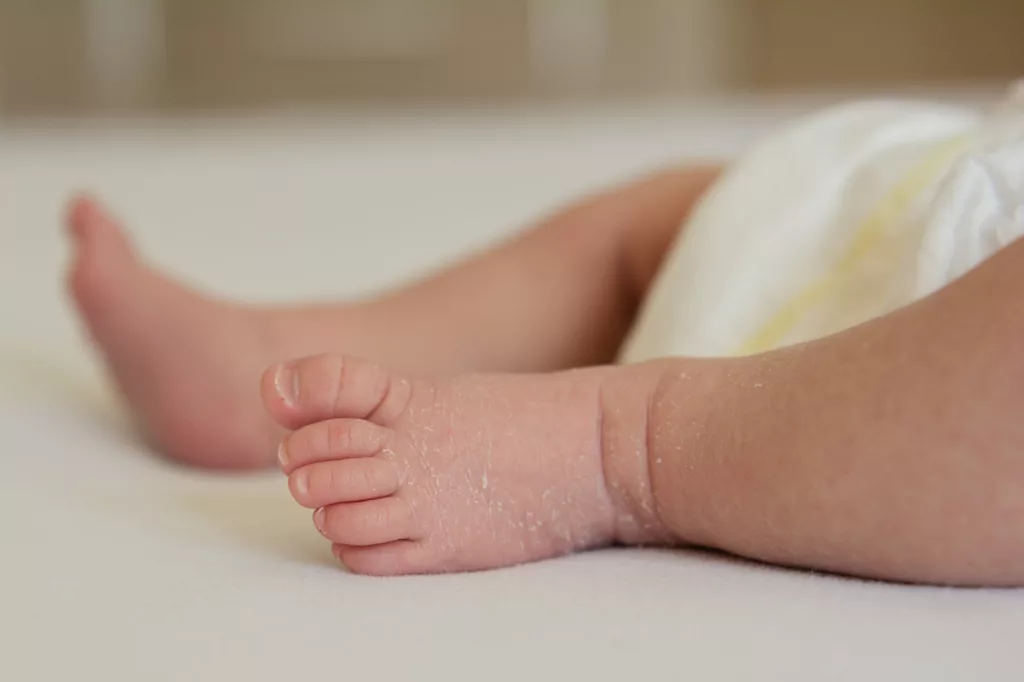
Both cradle cap and dry skin do not cause pain or itchiness, so there is no need to worry. These conditions are common and naturally occurring. Treatment for both is similar and can be done at home. Wash the hair and scalp, brush the hair with a soft baby comb or brush, and apply oil or petroleum jelly to soften the skin and hair, then gently massage to remove the flakes. For dry scalp and skin, wash the hair less frequently to retain your baby’s natural oils, and use specially formulated shampoo to restore your baby’s skin health.
Cradle Cap Vs. Dandruff
Dandruff differs from cradle cap in several key ways. While cradle cap mainly affects infants with greasy, yellowish flakes, dandruff occurs in older children and adults and is characterized by dry, white flakes. Dandruff is often also linked to an overgrowth of Malassezia yeast, as well as factors like oily skin, stress, or other conditions like seborrheic dermatitis. Unlike cradle caps, which are usually not itchy, dandruff can cause itching and irritation of the scalp. Additionally, dandruff tends to persist throughout life, whereas cradle cap typically resolves on its own in infants.8Borda LJ, Wikramanayake TC. Seborrheic Dermatitis and Dandruff: A Comprehensive Review. J Clin Investig Dermatol. 2015 Dec;3(2):10.13188/2373-1044.1000019. doi: 10.13188/2373-1044.1000019. Epub 2015 Dec 15. PMID: 27148560; PMCID: PMC4852869.
Conclusion
Cradle cap, or infantile seborrheic dermatitis, is a common skin condition characterized by yellow patches or scales and is greasy to the touch. The condition primarily affects the scalp. However, it can appear on the face, arms, external ear, or diaper area. It commonly affects babies between three months and the first few months and resolves itself in six to eight weeks. The treatment for cradle cap is conservative and includes washing and brushing your baby’s hair, applying moisturizer or oil to soften the area, and removing the crust or scales with a soft baby brush. Frequent hair washing will prevent scales from sticking firmly on the affected areas. The condition differs from eczema and dry skin because it does not cause pain, feeding issues, or itching for your baby.
Refrences
- 1Hassan, S., Szeto, M. D., Sivesind, T. E., Memon, R., Muneem, A., Victoire, A., Magin, P. J., van Driel, M. L., Nashawaty, M., & Dellavalle, R. P. (2022). From the Cochrane Library: Interventions for infantile seborrheic dermatitis (including cradle cap). Journal of the American Academy of Dermatology, 86(2), e87–e88. https://doi.org/10.1016/j.jaad.2021.09.031
- 2Naldi, L., & Diphoorn, J. (2015). Seborrhoeic dermatitis of the scalp. BMJ clinical evidence, 2015, 1713
- 3Nobles T, Harberger S, Krishnamurthy K. Cradle Cap. [Updated 2023 Aug 7]. In: StatPearls [Internet]. Treasure Island (FL): StatPearls Publishing; 2024 Jan-. Available from: https://www.ncbi.nlm.nih.gov/books/NBK531463/
- 4InformedHealth.org [Internet]. Cologne, Germany: Institute for Quality and Efficiency in Health Care (IQWiG); 2006-. Seborrheic dermatitis: Learn More – Seborrheic dermatitis in babies (cradle cap) [Updated 2024 Feb 1]. Available from: https://www.ncbi.nlm.nih.gov/books/NBK559360/
- 5Sheffield, R. C., Crawford, P., Wright, S. T., & King, V. J. (2007). Clinical inquiries. What’s the best treatment for a cradle cap? The Journal of family practice, 56(3), 232–233
- 6Schwartz, R. A., Janusz, C. A., & Janniger, C. K. (2006). Seborrheic dermatitis: an overview. American family physician, 74(1), 125–130
- 7(Strathie Page, S., Weston, S., & Loh, R. (2016). *Atopic dermatitis in children*. Australian Family Physician, 45(5), 293–296)
- 8Borda LJ, Wikramanayake TC. Seborrheic Dermatitis and Dandruff: A Comprehensive Review. J Clin Investig Dermatol. 2015 Dec;3(2):10.13188/2373-1044.1000019. doi: 10.13188/2373-1044.1000019. Epub 2015 Dec 15. PMID: 27148560; PMCID: PMC4852869.

